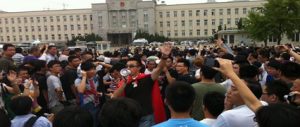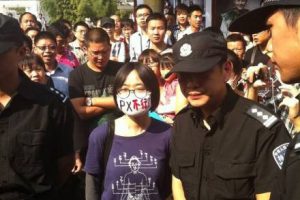“If we allow traditional media a bigger space to conduct rational analysis, we will be better able to solve such incidents, whether it’s the Sichuan copper protests or the wastewater protests in Qidong.”
This is how Zhu Gongjun, the section head of Southern Weekend’s environmental news, summarised his thoughts on the media’s coverage of environmental stories in 2012. He mentioned the protests over the copper smelting plant in Shifang, Sichuan and over a wastewater pipeline in Qidong, Jiangsu. Both of these public protests occurred in the summer of 2012, and in both cases the targeted projects were eventually halted. People were injured in clashes between the public and the police in Shifang; in Jiangsu, Qidong, the police did not take coercive measures, but city residents stormed the government building. Prominent features of both protests were a passive response by the government and an intensification of violence by the public.
Every time there is a community protest on environmental issues, including both these two, Weibo is always “flooded by comments”. Social media plays a double role of being a platform where information can be spread widely and it can also mobilise people. If you search for “Qidong incident” on Sina Weibo today, there are 459,792 results. If you search for “Shifang incident” there are 726,768 results. Compared with this, perhaps traditional media is collectively losing its voice on the control of news.
“The key feature of 2012 was how frequent environmental protests were, yet traditional media pretty much didn’t have the upper hand in covering them,” explains Zhu Gongjun.
However, Zeng Fanxu, associate professor at Tsinghua University School of Journalism and Communications, said traditional media still played an important role.
Zeng Fanxu and his colleagues concluded that in environmental protests, the public and the government are saying two different things, and they are very disconnected. Typically, the government line includes: economic development is crucial, and so it’s worth making sacrifices and compromises; technology has advanced enough; you can trust the government, and decisions are made based on science. Meanwhile the public line typically includes: in the end technology is controlled by people and so there must be some risk, there are relatively many problems connected with the decision-making process, and so on.
Zeng Fanxu believes that at this time it’s possible for traditional media to play a role in bringing both kinds of discourse together onto one platform, and eventually to bring about changes in policy.
They looked at those NIMBY campaigns that failed in the past few years, for example the Pengzhou PX incident and protests against petrochemical projects in Nanjing and Qingdao. They found that their common features were that the local official media had the dominant voice while the public struggled to get their voice heard. Non-local media talked about the risks of technology and the problem of communicating with the public, but these reports were not kept up and so there was not enough pressure to get both sides to talk communicate with each other. Whereas in most of those cases where the government backed down, both sides “talked to each other”. For example, the protest against a rubbish incinerator in Beijing’s Liulitun.
Zeng Fanxu believes that whenever traditional media cannot publish something because of a clamp down, and when the public have to rely on social media to voice their demands, then it is more likely that the situation will turn violent.






